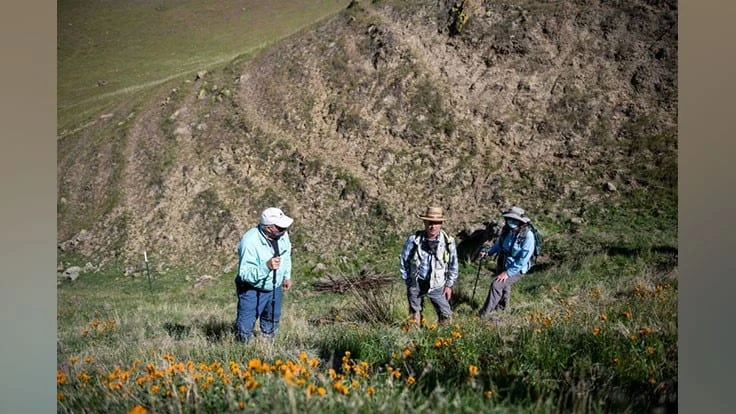
Provided by Beth LaBerge/KQED
It’s a sunny day in April, and a group of native plant experts, wildlife officials, and others are about to hike up a steep slope in the Altamont Pass region.
From the bottom of the hill, they can already see the signature, bright, bursting orange of the Amsinckia grandiflora, the large-flowered fiddleneck. On a crease on a hill where one side is all rock, the fiddleneck stands out among the gray and brown landscape.
This site has about 6,500 fiddleneck plants now, and the species would not be growing here if it weren't for a a massive repopulation effort that began about a decade ago.
The location is strictly classified because the large-flowered fiddleneck is critically endangered. In fact, the plant is so rare it’s been dubbed the California condor of botany. This group is not about to let anyone snatch these precious plants away.
The fiddleneck has struggled to complete with invasive grasses that arrived hundreds of years ago, and its decline has accelerated over the last century, says Roger Raiche, co-founder of Planet Horticulture, a landscape and garden design studio.
The climate has been getting hotter and drier since the ice age, and plants like the large-flowered fiddleneck that prefer cool, moist, shady habitats tend to lose out, he said. The fiddleneck has struggled to compete with the non-native plants dominating the landscape.
The quest to study and repopulate the large-flowered fiddleneck goes back to at least the 1960s. Researchers over the last few decades established committees, poured over maps, and spent hundreds of thousands of dollars. But when there were glimmers of hope, they didn't last. The large-flowered fiddleneck loves steep slopes, but that can lead to problems.
“There was a rainy winter and the whole thing slid away in a landslide,” Raiche said. “And nothing came back.”
But mapping technology has changed plant conservation. Vollmar Natural Lands Consulting specializes in using technology to create habitat models for endangered species. In 2012, Jake Schweitzer, a senior ecologist and geographic information science specialist with the company, landed a grant with the Bureau of Reclamation to repopulate the species.
The team working to repopulate the species traversed tens of thousands of acres, and surveyed areas more intensely based on a habitat model Schweitzer developed to narrow down the search. The species would need to be in shade throughout most of its life cycle.
But the majority of sites that could work were on private land. Schweitzer would need to ask ranchers for permission to grow an endangered plant on their property.
The team ended up working with six landowners, but this effort was constantly threatened by severe drought conditions. And then they also needed to figure out just the right amount of cattle grazing.
It was like any trial and error experiment, but eventually it paid off. Schweitzer says it’s likely that when the seeds get caught in the cow's hooves, the cows spread them around. The cows also press the seeds into the soil, making it less likely for birds or rodents to eat them.
By around 2018, the results were looking promising, and Schweitzer was feeling hopeful. The plants were thriving. Schweitzer remembers looking out and seeing 10,000 of them growing on a slope with big, luscious flowering branches that he knew were likely to produce a lot of seeds.
The team is hoping the species now has a large enough population to hold on. The large-flowered fiddleneck population is not gone yet, but it’s still at risk.
Read the full story here.
Latest from Greenhouse Management
- 2025 Proven Winners Horticulture Scholarship applications now open
- How to improve inventory and shipping management in the greenhouse
- Leading Women of Horticulture: Anna Ball, Ball Hort, and Terri McEnaney, Bailey Nurseries
- GM CEA HERB Part 2: A guide to increasing the sowing density of culinary herbs
- GM CEA HERB Part 1: Best practices for producing culinary herbs in controlled environments
- USDA fires experts on invasive pests, including Asian citrus psyllid, chilli thrips
- CEA Alliance celebrates bipartisan introduction of Supporting Innovation in Agriculture Act
- Dümmen Orange North America celebrating 25th anniversary in 2025






